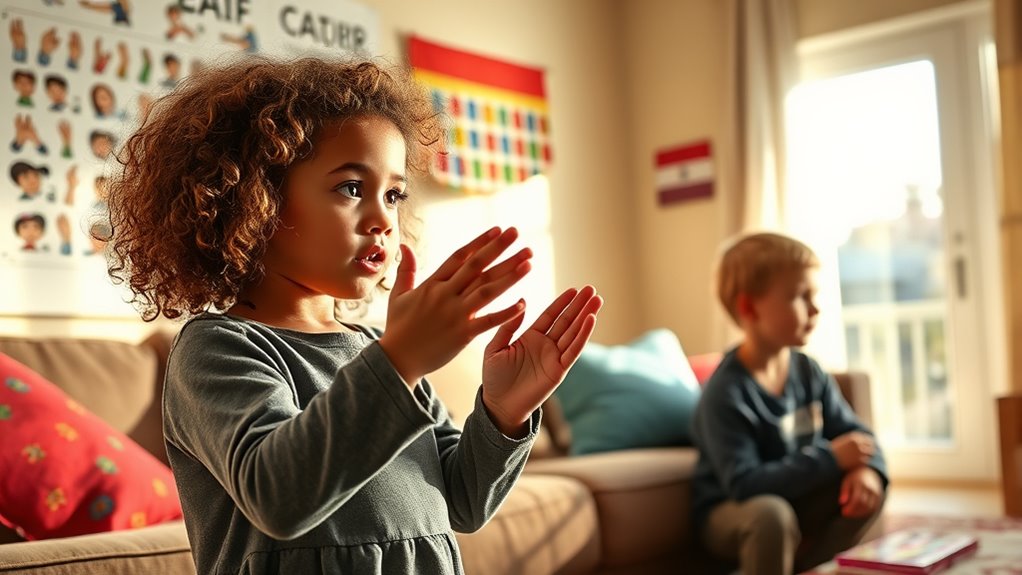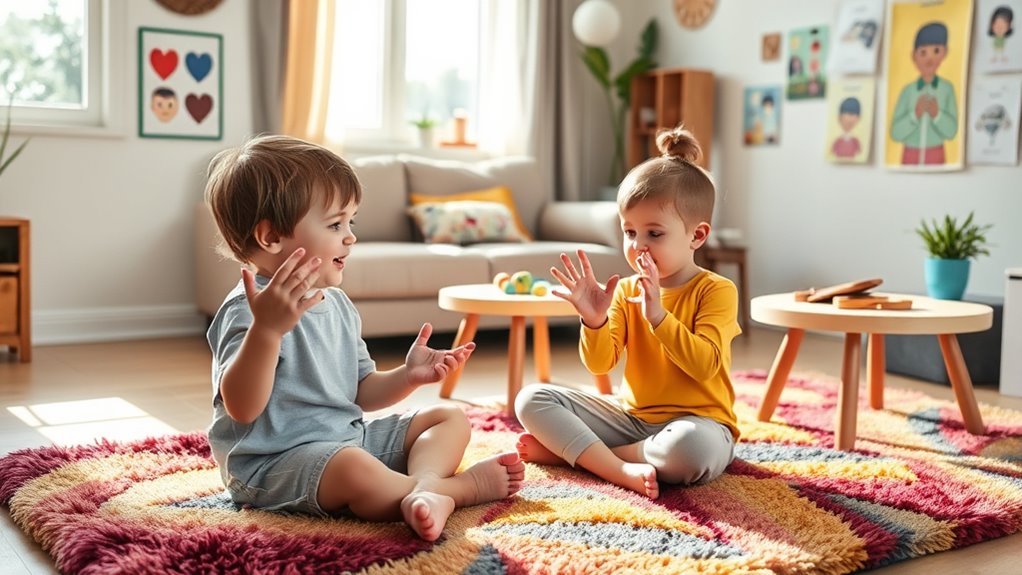To teach your siblings about deaf culture, involve them in local deaf events like festivals or storytelling sessions to foster understanding and appreciation. Share stories and books with deaf characters, and practice sign language together using apps or flashcards. Participating in deaf celebrations and exploring deaf art helps make the culture more real and approachable. Supporting your sibling and advocating for accessibility also shows respect. Keep exploring different ways to connect, and you’ll discover even more meaningful ways to share deaf culture.
Key Takeaways
- Introduce deaf culture through participation in deaf festivals, storytelling, art, and cultural events to foster understanding and appreciation.
- Teach basic sign language skills together using flashcards, videos, and community classes to promote inclusive communication.
- Share deaf stories, books, and sensory activities that highlight deaf experiences and normalize deafness in everyday life.
- Engage in deaf-inclusive activities and celebrations to deepen cultural connection and demonstrate community support.
- Advocate for deaf siblings by learning about their needs, supporting accessibility, and promoting empathy within family and community contexts.
Exploring Deaf Culture and Community Events

Attending deaf community events like Deaf festivals, rallies, and sign language gatherings allows siblings to experience deaf culture firsthand. These community events open a window into the rich traditions, history, and shared experiences of deaf individuals. Participating in activities such as Deaf Awareness Week or International Week of the Deaf helps you learn about deaf rights and cultural practices. Engaging with deaf role models and community members during these events deepens your understanding of the cultural identity that unites the deaf community. Learning and using sign language at these gatherings not only improves your communication skills but also shows respect for deaf culture. These experiences encourage you to appreciate the diversity and depth of deaf culture beyond just language, fostering greater awareness and connection. Recognizing the importance of privacy and cookie usage can also help you understand how online information about deaf culture is shared and protected. Being aware of cultural sensitivity enhances respectful interactions and supports inclusive community participation.
Using Stories and Books to Foster Understanding

Have you ever wondered how stories can help children understand deafness and deaf culture? Storybooks featuring deaf characters, like a deaf mouse read at bedtime, make communication differences relatable and normalize deafness.
Stories featuring deaf characters help children relate to and normalize deafness naturally.
Books like Julia Donaldson’s ‘Freddie and the Fairy’ introduce deaf culture through engaging stories that foster understanding.
‘Let’s Sign’ books and flashcards provide visual and tactile resources, making it fun for siblings to learn basic BSL signs and communication techniques.
Using these story-based resources allows siblings to explore feelings, ask questions, and develop empathy naturally.
Community story sessions, such as those at preschool groups like Happy Hands, further promote early awareness.
Learning Sign Language Together

Learning sign language together with your siblings creates a meaningful bond and promotes inclusive communication at home. You can use visual resources like ‘Let’s Sign’ books and flashcards to make learning engaging and effective. Practice daily during meals, playtime, or quiet moments to reinforce skills and build confidence. Participating in community classes, such as Happy Hands, offers real-world practice and fosters social interaction with deaf peers. Sharing milestones and progress keeps everyone motivated and deepens your understanding of deaf culture. Here’s a simple way to visualize your learning journey:
| Visual Resources | Practice Activities |
|---|---|
| Flashcards, books | Signing during meals |
| Videos, apps | Playtime signing |
| Sign language games | Group sessions |
| Sign milestone charts | Celebrations |
Additionally, incorporating sensory toys into your practice can enhance tactile learning and help reinforce sign language skills through hands-on engagement. Understanding deaf culture helps create a respectful and supportive environment for learning and communication. Recognizing the importance of inclusive education encourages ongoing growth and connection within your family and community.
Participating in Deaf-Inclusive Activities and Celebrations

Participating in Deaf-inclusive activities and celebrations allows you to experience Deaf culture directly. Attending events like festivals or community rallies helps you learn about Deaf history, art, and traditions. Engaging in cultural events that showcase Deaf storytelling and performances further deepens your understanding of the community’s unique expressions. These experiences also promote cultural intelligence, fostering greater empathy and effective communication with Deaf individuals. Additionally, exploring diverse celebration customs enhances your appreciation for how different communities honor their traditions. Recognizing the importance of environmental considerations, such as using accessible and inclusive spaces, can also enrich your participation and understanding of Deaf community practices. Incorporating interior design principles that prioritize accessibility can make these environments more welcoming and functional for all attendees.
Celebrating Deaf Culture Events
Celebrating Deaf Culture Events offers a powerful way for siblings to connect with the deaf community and deepen their understanding of deaf identity. Attending Deaf culture events like Deaf festivals, Deaf awareness days, and community rallies immerses you in the vibrant traditions and shared pride of deaf culture. Participating in sign language workshops and Deaf community celebrations enhances your appreciation of deaf language and history. Visiting deaf art exhibitions or attending deaf film festivals exposes you to creative expressions from deaf artists, fostering cultural exchange. These experiences help you see deaf community celebrations as more than events—they’re opportunities to build respect, support deaf identity, and forge meaningful connections with deaf individuals and their culture. Incorporating unique and creative ways to celebrate and learn about deaf culture can further enrich these experiences and foster a deeper understanding.
Engaging in Inclusive Activities
Engaging in inclusive activities allows siblings to experience Deaf culture directly and meaningfully. Participating in events like Deaf rallies, cultural festivals, and holiday celebrations immerses you in Deaf culture firsthand. You might attend sign language workshops or join family sign-along sessions, fostering understanding and shared participation. Celebrating Deaf awareness days, such as International Week of the Deaf, involves educational activities and cultural exchanges that deepen your connection. Community programs like Happy Hands or local groups for deaf children and their siblings create opportunities for social interaction. Additionally, storytelling sessions with Deaf role models or accessible sports and arts events promote active inclusion and appreciation of Deaf culture. Engaging in such activities can also enhance your awareness of store hours, which include regular, holiday, and special event timings, helping you plan visits effectively. Understanding the Key steps in the deaf community’s cultural events can further enrich your experience and appreciation of Deaf traditions. Incorporating knowledge about Glycolic Acid benefits into your skincare routine can also be part of your self-care, fostering confidence and a positive self-image. Being aware of the potential pitfalls in adopting new payment technologies can help you navigate financial transactions securely and confidently. These activities help you embrace diversity and build lasting bonds with the Deaf community.
Promoting Respect and Empathy Through Shared Experiences

Sharing experiences at deaf community events allows siblings to gain a genuine understanding and develop respect for deaf culture. Participating in sign language activities together fosters empathy by enabling you to communicate in ways deaf individuals do daily. Learning about deaf history and role models deepens appreciation for deaf culture’s contributions. Engaging in shared storytelling and games that highlight deaf practices encourages hands-on understanding, strengthening your bond. Recognizing the diversity within deaf culture, including different communication preferences, nurtures respect and openness. Incorporating natural materials into your activities can create a more immersive and sensory-rich learning experience. Exploring communication methods used within deaf communities can further enhance understanding and appreciation for diverse ways of connecting. Observing cultural events can provide valuable insights into the traditions and values that shape deaf culture. Understanding the importance of cultural significance in deaf practices helps underscore the richness and depth of deaf culture beyond just language. Additionally, learning about deaf community organizations can offer valuable resources and support networks for ongoing engagement.
Supporting Your Sibling and Advocating for Accessibility

Supporting your sibling involves actively advocating for their needs and promoting accessibility in your family and community. You can do this by:
Supporting your sibling means advocating for their needs and promoting accessibility in your community.
- Learning sign language to improve communication and show empathy.
- Participating in deaf awareness activities to foster inclusion and understanding.
- Respecting deaf culture as an essential part of your sibling’s identity and advocating for its recognition.
- Sharing knowledge about deaf culture with friends and peers to raise awareness and promote accessibility.
- Recognizing the importance of imagination in fostering empathy and understanding for diverse experiences, including deaf culture. Developing empathy helps bridge communication gaps and builds stronger relationships with your sibling and others who are deaf or hard of hearing. Your advocacy helps break down barriers and creates an environment where your sibling feels supported and understood.
Frequently Asked Questions
What Are 4 Cultural Behaviors in the Deaf Culture?
You’re asking about four cultural behaviors in Deaf culture. First, eye contact is essential, helping you communicate effectively through visual cues.
Second, using sign language shows respect and promotes inclusivity.
Third, being direct and honest reflects the value placed on authentic communication.
Finally, celebrating Deaf pride through events and sharing Deaf stories helps you connect with the community and honor its identity.
These behaviors foster understanding and respect within Deaf culture.
What Are 5 Good Examples of Deaf Culture?
Deaf culture includes many vibrant examples. You might attend Deaf festivals, where communities celebrate with sign language, music, and art.
Using visual alerts and captioning shows your respect for accessibility. Learning and sharing Deaf stories and history helps you connect deeply.
Participating in community events like rallies or social gatherings strengthens bonds.
Appreciating Deaf humor and art forms highlights the rich, expressive nature of Deaf culture that you can embrace and share.
Is It OK to Say Deaf Culture?
Yes, it’s okay to say “Deaf culture.” You should use this term because it reflects the shared language, traditions, and community bonds of deaf individuals. It emphasizes that deafness isn’t just a medical condition but a unique cultural identity.
Using “Deaf culture” shows respect, promotes understanding, and helps break down stigmas. So, whenever you talk about deaf communities, this term is appropriate and respectful.
What Is a Sibling of a Deaf Individual Called?
Think of a sibling of a deaf individual as part of a vibrant family, much like the members of a close-knit crew. They’re often called “deaf siblings” or “siblings of deaf children,” but no single term is universal.
Some communities simply use “brother” or “sister,” while others recognize them as part of the “deaf family,” emphasizing their shared identity and connection within deaf culture.
Conclusion
By embracing Deaf culture with your sibling, you’re building bridges of understanding and respect. Think of it like learning a new dance—at first, it’s unfamiliar, but as you practice together, the steps become natural, and you move in harmony. Just as a community thrives on shared experiences, supporting your sibling fosters connection and empathy. Your efforts create a world where both of you dance confidently, celebrating differences and embracing inclusion every step of the way.











